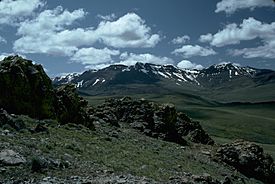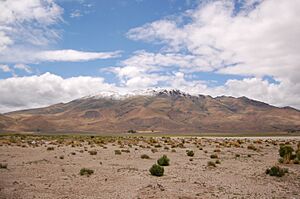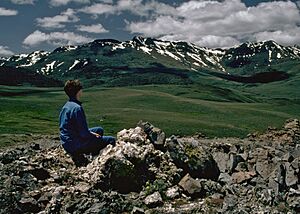Pueblo Mountains facts for kids
Quick facts for kids Pueblo Mountains |
|
|---|---|

Pueblo Mountains south of Fields, Oregon
|
|
| Highest point | |
| Peak | Pueblo Mountain |
| Elevation | 8,632 ft (2,631 m) |
| Dimensions | |
| Length | 30 mi (48 km) north–south |
| Width | 22 mi (35 km) west–east |
| Area | 356 sq mi (920 km2) |
| Geography | |
| Country | United States |
| Geology | |
| Age of rock | Triassic and Cretaceous |
| Type of rock | Uplifted sedimentary and volcanic |
The Pueblo Mountains are a special mountain range found mostly in southeastern Oregon and a bit in northwestern Nevada, in the United States. The tallest spot here is Pueblo Mountain. You'll mostly see grasses and big sagebrush plants. But in some meadows near streams, there are groups of cottonwood, aspen, and willow trees. Most of these mountains are public land. They are looked after by the Bureau of Land Management, which is a government group. Not many people live or build things in the Pueblo Mountains. Most visitors come to go backpacking across the land, camping, and hunting.
Contents
What Are the Pueblo Mountains Like?
The Pueblo Mountains are in Harney County, Oregon, and Humboldt County, Nevada. They are part of a bigger area called the Basin and Range Province in the Western United States. This area has many long mountain ranges that run north to south. Wide, dry valleys separate these ranges.
The Pueblo Mountains cover about 356 square miles (922 km2). They stretch 30 miles (48 km) from north to south and 22 miles (35 km) from east to west. The highest point is Pueblo Mountain. It stands 8,632 feet (2,631 meters) above sea level. This peak is in Oregon, about 8 miles (13 km) north of the Nevada state line. West Pueblo Ridge is just west of Pueblo Mountain. It is the second highest spot, at 8,420 feet (2,566 meters).
The land has rough ridges with steep sides. Seasonal streams have cut deep paths into these ridges. High, dry basins separate the ridges. You can find green meadows around springs. Two of the biggest meadows are Machine Meadow and 10 Cent Meadow. Only a few streams in the Pueblo Mountains flow all year. These include Van Horn Creek and Denio Creek.

How Were the Pueblo Mountains Formed?
The Pueblo Mountains are made of the same basalt rock that covers much of southeastern Oregon. Much older metamorphic rocks are found under these newer basalt layers. You can see these older rocks on the east side of the mountains. They might be linked to very old rock formations from the Triassic Period in the Blue Mountains to the north. These rocks also have diorite and granodiorite rocks mixed in. These probably formed during the Cretaceous Period. The southern part of the Pueblo Mountains has metamorphic rocks with lots of quartz. These rocks also contain gold, silver, and copper.
Plants and Animals of the Pueblo Mountains
The plants in the Pueblo Mountains are mostly big sagebrush and desert grasses. Some common grasses are Idaho fescue, bluebunch wheatgrass, and cheatgrass. You can find high mountain meadows near springs. Narrow green areas follow the streams that flow all year. Some of these green areas have cottonwood, aspen, and willow trees.
Many colorful wildflowers grow in the meadows and high desert. These include larkspur, Indian paintbrush, cinquefoil, shooting star, columbines, monkey flower, asters, buttercups, and lupin. You might also see arrowleaf balsamroot, penstemon, mariposa lily, and iris.
The animals in the Pueblo Mountains are used to living in the high desert. Pronghorn are often seen in the open, sagebrush areas. Mule deer prefer the cottonwood and willow groves. The Oregon Department of Fish and Wildlife brought bighorn sheep to the Pueblo Mountains in 1976, 1980, and 1983. Now, you can find them on the steep slopes and high rocky edges.
Jackrabbits, antelope ground squirrels, bushy-tailed woodrats, and coyotes live all over the mountains. Small-footed myotis bats are also common. Beavers can be found in 10 Cent Meadow and some mountain streams. Birds like the sage grouse, canyon wren, rock wren, valley quail, and chukar live here. Larger birds like golden eagles, red-tailed hawks, turkey vultures, and ravens fly high above the mountains. Rare Whitehorse Basin cutthroat trout also live in Van Horn Creek and Denio Creek.
How People Use the Pueblo Mountains
Most of the land in the Pueblo Mountains is managed by the federal Bureau of Land Management. This mountain range is very far away from cities. Because of this, not many people visit. The most popular things to do are hiking, camping, hunting, horseback riding, watching wildlife, and taking pictures. People also let their cattle graze here. There are also places where people have mining claims. The Pueblo Mountains are also being checked to see if they are good places for wind power.
There is no special wilderness area in the Pueblo Mountains. But traveling here can be very hard. The Desert Trail goes through the mountains. However, it is not a normal hiking trail. The path is only marked by piles of rocks called cairns. These cairns help hikers find their way across the dry land from one marker to the next. The Bureau of Land Management, the Oregon Parks and Recreation Department, and the Desert Trail Association (a private group) worked together to build these cairns. The Desert Trail Association makes a map for hikers. It shows how to use a compass and map to go from cairn to cairn.
People started letting Cattle and sheep graze in the Pueblo Mountains in the mid-1860s. This was when the first ranches were built along the eastern edge of the mountains. Today, the Bureau of Land Management manages where animals can graze. Cattle can be seen grazing in some mountain meadows and open areas in the spring and summer.
Miners were some of the first people to explore the Pueblo Mountains. There are at least 18 places where mining happened in the past. But mining for money has never worked well here. Today, some mining claims are still active in the Pueblo Mountains. You can also find a few old, empty miners' cabins.
People are now looking into using the Pueblo Mountains for wind power. In 2006, the Bureau of Land Management allowed a test for wind energy. A private company put up two weather poles in a 468-acre (1.9 km2) area. These poles check weather conditions to see if the winds are strong and steady enough for big wind farms. In 2009, the Bureau of Land Management let the company continue the test for three more years.



